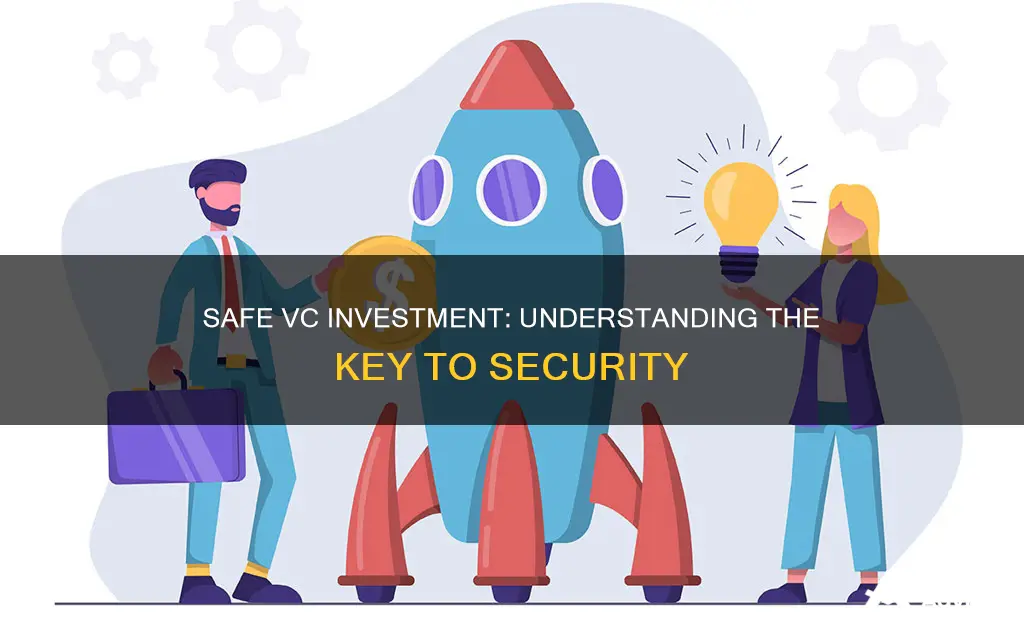
SAFE, an acronym for Simple Agreement for Future Equity, is a popular financial instrument in the startup ecosystem, primarily used by early-stage companies. It was introduced by Y Combinator in 2013 to help founders of pre-revenue companies raise their first round of funding. SAFEs are a form of convertible financing, allowing investors to convert their cash investments into equity when specified events occur, often at a discount or a maximum value. While SAFEs have skyrocketed in popularity, they have been criticized for several reasons, including the misalignment of interests between SAFE holders and founders.
What does SAFE mean in VC Investment?
| Characteristics | Values |
|---|---|
| Full Form | Simple Agreement for Future Equity |
| Introduced by | Y Combinator |
| Introduced in | 2013 |
| Type | Convertible financing |
| Use case | Early-stage startup investing |
| Benefits | Speed, cost-effectiveness, simplicity, customisable terms, flexibility, aligning investor and startup success, lowering the potential for diluting founders' stakes |
| Drawbacks | Lack of interest payments, dilution risk for future rounds of financing, misalignment of interests between SAFE holders and founders, uncertainty for investors |
| Tax implications | Not taxable at the time of investment but becomes taxable upon conversion into equity |
What You'll Learn
- SAFEs are Simple Agreements for Future Equity, introduced in 2013
- SAFEs are a popular financial instrument for early-stage startups
- SAFEs are different from convertible notes, which are debt instruments
- SAFEs don't provide immediate ownership, and investors may lose out if the startup fails
- SAFEs are criticised for misalignment of interests between SAFE holders and founders

SAFEs are Simple Agreements for Future Equity, introduced in 2013
SAFE stands for "Simple Agreement for Future Equity". Y Combinator introduced this concept in 2013 after finding that founders of pre-revenue companies were struggling to raise their first round of funding.
SAFEs are a form of convertible financing. They are different from convertible notes in that they are not a debt instrument, and they are usually simpler and shorter. SAFEs are typically associated with seed-stage funding, given their simplicity and the flexibility they provide to manage an uncertain valuation. They are a popular financial instrument in the startup ecosystem, primarily used by early-stage companies. Startups can use SAFEs to adapt to changes while securing funding without providing immediate equity stakes or determining a set value for their shares.
SAFEs let investors convert their cash investments into equity when specified events occur, often at a discount or a maximum value. The terms of the conversion, including the valuation cap and the discount rate, are negotiated between the investor and the startup. The valuation cap sets the maximum valuation at which the SAFE can convert into equity, while the discount rate applies a percentage discount to the valuation cap at the time of conversion.
SAFEs offer several benefits for investors and startups, such as speed and cost-effectiveness. However, they also come with potential drawbacks and considerations. One of the main disadvantages of using SAFEs is the lack of interest payments, which means that investors will not receive a return on their investment until a triggering event occurs in the future. Another potential drawback is the dilution risk for future rounds of financing. Since SAFEs are designed to convert into equity at a future date, there is a risk that the startup will raise additional capital at a lower valuation, which could dilute the value of the initial investment.
Nippon India ETF Nifty Bees: A Beginner's Guide to Investing
You may want to see also

SAFEs are a popular financial instrument for early-stage startups
SAFE stands for "Simple Agreement for Future Equity". It is a financial instrument that allows investors to provide funding to startups without receiving equity upfront. Instead, investors have the option to convert their investment into equity at a later date, typically during a significant funding event or a triggering event such as a future round of financing or the acquisition of the startup. SAFEs are commonly used in early-stage startup investing as they offer speed, cost-effectiveness, and flexibility in managing uncertain valuations. They are also simpler and shorter than other investment instruments, making them attractive to both founders and investors.
One of the key benefits of SAFEs for startups is that they provide a straightforward way to raise capital without giving up ownership stakes or determining a set value for their shares. This allows startups to adapt to changes and secure funding early on in their journey when determining an accurate valuation is challenging. The simplicity of SAFEs also reduces the negotiation process, as the primary discussions revolve around the investment amount and the valuation cap.
For investors, SAFEs offer the potential for high returns with relatively low risk. The lack of immediate equity ownership means that investors will not have voting rights or influence in the company's operations, and their return on investment will depend on the startup's success and the terms of the conversion. The valuation cap and discount rate are key factors in determining the potential returns for investors. The lower the valuation cap and the higher the discount rate, the more favourable the terms are for investors.
Despite their popularity, SAFEs have been criticised for several reasons. One of the main issues is the potential misalignment of interests between SAFE holders and founders, which can create tension during the fundraising process. Additionally, SAFEs may provide minimal protection for investors if the startup does not perform as expected. There is also a risk of dilution for future rounds of financing, as the startup may raise additional capital at a lower valuation, diluting the value of the initial investment.
Overall, SAFEs are a popular financial instrument for early-stage startups as they offer a flexible and cost-effective way to raise capital, providing investors with the potential for high returns. However, it is important for both startups and investors to carefully review and negotiate the terms of a SAFE to ensure they align with their needs and goals.
Protecting Your S Corp Investments: Strategies for Mitigating Risk
You may want to see also

SAFEs are different from convertible notes, which are debt instruments
SAFE, an acronym for Simple Agreement for Future Equity, is a financial instrument that allows investors to convert their cash investments into equity when specific events occur, such as a funding round or a sale. It was introduced by Y Combinator in 2013 to simplify seed funding for early-stage companies. SAFEs are not debt instruments and do not require repayment of the investment with interest. They are typically associated with seed-stage funding due to their simplicity and flexibility in managing uncertain valuations.
Convertible notes, on the other hand, are short-term debt instruments that can be converted into equity upon certain events, such as a priced equity round or liquidation. They are a type of loan that gives investors the right to convert their debt into equity. Convertible notes are typically used when a company has a reasonable valuation and can agree on terms, as they require the company to raise a certain amount of capital for automatic conversion into equity.
One key difference between SAFEs and convertible notes is the presence of a maturity date in the latter. The maturity date is the deadline by which the convertible note must be repaid with interest, typically 18-24 months after the initial investment. If the startup fails to raise funds or achieve the specified event by the maturity date, the noteholders may demand repayment of the principal and any accrued interest. SAFEs, on the other hand, do not have a maturity date, providing more flexibility and removing the time pressure on founders to raise funds or negotiate extensions.
Another distinction lies in the interest rates associated with convertible notes. Convertible notes come with an interest rate, which is usually in the range of 2% to 8%. The interest accrued on the principal amount is also converted into equity upon a triggering event. In contrast, SAFEs do not involve interest rates or accruals because they are not debt instruments. This absence of interest obligations reduces the financial burden on startups.
Additionally, the conversion process differs between SAFEs and convertible notes. SAFEs prescribe a specific conversion method, whereas convertible notes offer varying conversion terms. SAFEs typically convert at any dollar amount raised during the next preferred stock round, while convertible notes usually require the company to raise a certain amount for automatic conversion. SAFEs provide more certainty to investors regarding their ownership stake, whereas convertible notes offer more variable payout options.
In summary, SAFEs and convertible notes are both convertible securities used in startup fundraising. However, SAFEs are distinct from convertible notes as they are not debt instruments. SAFEs offer advantages such as simplicity, no maturity dates, and no interest obligations, making them a popular choice for early-stage companies seeking a straightforward and flexible funding option.
Strategic Timeline for High-Risk Investments: A Guide
You may want to see also

SAFEs don't provide immediate ownership, and investors may lose out if the startup fails
SAFE, an acronym for Simple Agreement for Future Equity, is a financial instrument that was first introduced in 2013. It is a contract between an investor and a startup that gives the investor the right to receive equity in the company at a future date for the cash contribution made in the present, typically in connection with a future financing round.
SAFEs are structured as loans and are usually converted at a discount to factor in the additional risk the investor is taking. SAFE investments have become increasingly popular in recent years as they provide a way for startups to raise funds and finance their business without giving up equity or taking on debt.
However, one of the risks of SAFEs for investors is that they don't provide immediate ownership in the company. This means investors won't have equity or voting rights until the SAFE converts, which may never happen if the company doesn't survive until its later funding round. If the startup fails before the conversion event, SAFE investors may lose their entire investment.
For example, if a startup becomes financially self-sufficient, no longer requires additional funding, and isn't acquired by another entity, the conditions for converting the SAFE into equity might never be met. In such a scenario, the investor may not receive equity despite their initial investment. This is because SAFEs are generally viewed as derivative contracts providing rights to future equity ownership without an expiration date.
Therefore, it is crucial for investors to carefully consider the risks associated with SAFEs and to understand the full implications, including potential tax consequences and compliance with securities laws, before investing in early-stage startups using this instrument.
Private Equity: Minimum Investment Requirements Explained
You may want to see also

SAFEs are criticised for misalignment of interests between SAFE holders and founders
SAFE, or Simple Agreement for Future Equity, is a contractual agreement between a startup company and its investors. It was introduced by Y Combinator in 2013 to help founders of pre-revenue companies raise their first round of funding. SAFEs are a form of convertible financing.
SAFEs are criticised for causing a misalignment of interests between SAFE holders and founders. This is due to the fact that SAFEs do not accrue interest or have a maturity date. This means that founders do not have to worry about keeping track of interest or asking investors for extensions, but it also means that investors may have to wait a long time to convert their SAFE into equity. This could result in the costs of lost interest adding up over time.
Another point of criticism is the potential for equity dilution for founders. While SAFEs initially lower the risk of dilution, converting them into equity during subsequent funding rounds can dilute the founders' stakes more than originally anticipated. This could result in founders having much less control over their company than they expected.
Additionally, investors in SAFEs do not have immediate ownership of the company and will not have equity or voting rights until the SAFE converts. If the startup fails before the conversion event, SAFE investors may end up with nothing. This creates a misalignment of interests as the founders are working to ensure the success of the company, while SAFE holders are primarily focused on their return on investment.
Furthermore, there is a risk that triggering events in a SAFE may never occur, leaving investors without equity. For example, if a startup becomes financially self-sufficient and no longer requires additional funding, the conditions for converting the SAFE into equity may never be met. This scenario could result in the investor losing their initial investment, creating a further misalignment of interests between SAFE holders and founders.
Overall, while SAFEs offer benefits such as simplicity and flexibility, they also carry the risk of misalignment between SAFE holders and founders due to factors such as the lack of interest accrual, potential dilution, and uncertainty around conversion events.
Finding Safe Investments: Strategies for Financial Security
You may want to see also
Frequently asked questions
SAFE stands for "Simple Agreement for Future Equity". It is a form of convertible financing.
A Simple Agreement for Future Equity (SAFE) is a popular financial instrument in the startup ecosystem, primarily used by early-stage companies. Startups can use it to adapt to changes while securing funding without providing immediate equity stakes or determining a set value for their shares.
SAFEs allow investors to convert their cash investments into equity when specified events occur, often at a discount or a maximum value. The terms of the conversion, including the valuation cap and the discount rate, are negotiated between the investor and the startup.
SAFEs offer a flexible and straightforward way for startups to raise capital while providing investors with the potential for high returns with relatively low risk. They are also cost-effective, simple, and faster to negotiate because they don't involve immediate equity ownership.
One of the main disadvantages of using SAFEs is the lack of interest payments, which means that investors will not receive a return on their investment until a triggering event occurs in the future. Another potential drawback is the dilution risk for future rounds of financing.







